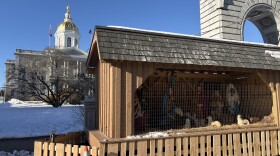Winter feels far away right now, but farmers looking to grow winter crops - and there are a growing number of them - are starting to think about what they’ll put in their greenhouses.
A new project at the New Hampshire Agricultural Experiment Station aims to help these winter growers. Brian Krug, UNH Cooperative Extension specialist on greenhouse and floriculture plants and researcher at the Agricultural Experiment Station told us about research on hydroponic greenhouse growing.
What’s driving the growth in winter crops, Krug says, is the growing demand for local food year-round - especially for salad greens and other crops that aren't easily preserved. "In the past we've had to ship those in from other parts of the country or other parts of the continent where they can grow those in outdoor situations," Krug says. "With these winter farmers markets, one option for getting local greens is to grow those in a greenhouse."
Krug's research looks at hydroponic growing, which uses an inert medium such as sand - "we don't use the term 'soil,'" Krug notes - and nutrient-rich water solutions to grow plants. In particular, the study will look at which types of plants will tolerate the cold and lower light New Hampshire sees in winter. "Heating is a big expense," Krug says. "What grows well in a greenhouse is different than growing in a field."
Krug says the hope is to find cultivars and crops that "maybe are unique to things that might not be available at the supermarket, that growers can use as a niche for the farmers markets." Whatever those are, he says the goal is to meet that growing demand for local greens, even in the middle of winter.
"Just having that fresh produce that hasn't been shipped many, many miles - that hopefully has been harvested the day before or the day of, when the consumer purchases it, that you still have that really fresh flavor."








